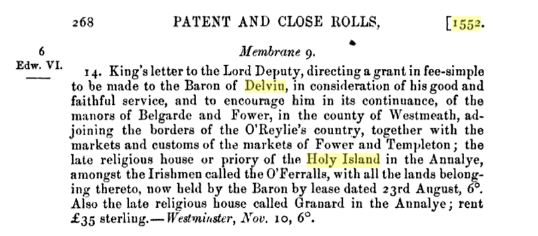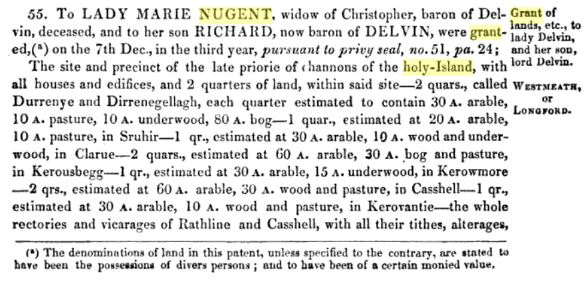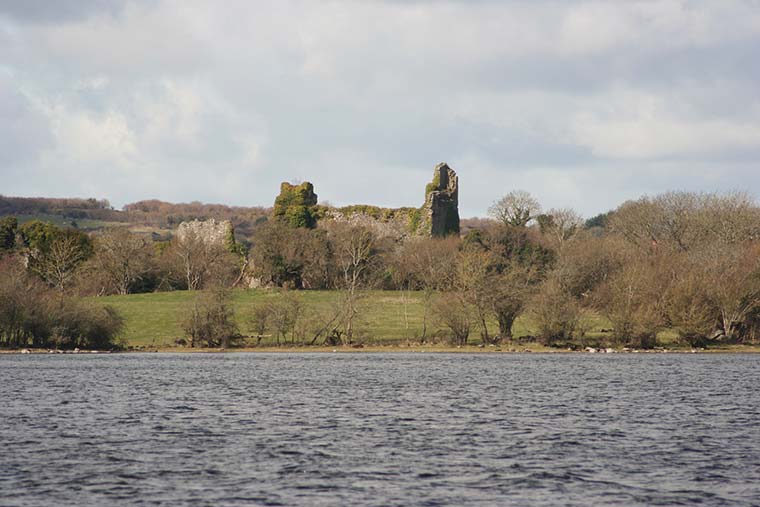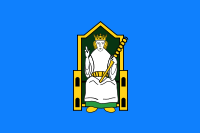Lord Baron of Inchcleraun Island
Priory and Lands of The Holy Island to Lord Delvin 1552 by King Edward VI
![[ocr errors] [ocr errors]](https://books.google.com/books/content?id=9ldLAQAAMAAJ&output=text&pg=PA136&img=1&zoom=3&hl=en&q=place+names+of+longford&cds=1&sig=ACfU3U0DuFCpwkmMq6ChxU2Kgy-2O1iHIw&edge=0&edge=stretch&ci=171,798,652,78) Also Known as Quaker Island
Also Known as Quaker Island
INISHCLOTHRAN
InishClothran: - Commonly known as Quaker Island: derives its
name from Clothran, Sister of Maeve, Queen of Connaught who had her place at Croghan. The interest of this
Island is its connection with primitive Celtic Christianity.
This island formerly formed part of the kingdom
of Hy-Many. It is now included in the County Longford. Clothra was the mother of Lughaidh who was, at a
remote period, king of Ireland. “In the reign of Lughaidh the lakes Neagh and Ree began to make their
appearance.” St. Diarmid, patron of Inis Clothrann was brother of St. Fedliminus, who was Bishop of Kilmore;
both were descended from Dathy, the last pagan king of Ireland, who was killed in year 427.
St. Diarmid was the teacher of St. Ciaran of
Inisangin, afterwards the founder of Clonmacnoise. Inis Clothrann, as a religious seat, is probably older
than Clonmacnoise. St. Diarmid wrote a pious work which the learned Colgan states was in his possession. His
festival is honoured on the Ioth of January. St. Diarmid's church, measuring eight feet by seven, is said to
be the smallest in Ireland. To the north-west of Grianan Meadhbha, or Queen Meave's palace, is Temple Clogas,
the first church erected by St. Diarmid on Inis Clothrann. The belfry of this church was thirty feet high and
its bell so loud-sounding as to be heard a distance of seven miles. It is one of the few ancient square
belfries now existing in Ireland.
“I shall visit Inis Clothrann,
Which exceeds all the others far in beauty.
It was on this isle of grass and beauty
That Meave of Croghan, Queen of Connaught,
Fell by the son of the King of Uladh.
In time of war and bloody murders,
The Clanna Rory and the sons of Uisneach,
Mighty men of strength and courage,
Rose up to war and emulation,
For one fair damsel, yoleped Deirdre.
Five hundred years after the Saviour Had suffered for the
sins of mankind, The holy Diarmid here erected Seven churches and a steeple; He also placed on Inis Clothrann, That
beauteous, fertile, airy, island, Two convents of which the ruins Are to be seen still on the island.” —MSS. of
Ord. Survey. This island, sometimes called “ Quaker Island,” also “Island of the Seven Churches,” is about one mile
long and one-third of a mile broad. By reason of its churches it is the most important island in Lough Ree. From
the middle of the eighth to the end of the thirteenth century, bishops, priests, poets, historians, professors,
princes, chiefs, without count, lived, died, and were buried, on this holy isle. “Fair City of the Lake, the day is
long gone past, When choral voices lent rich echoes to the blast.”
Inchcleraun (Irish: Inis
Cloithrinn), also called Quaker Island or Holy Island, is an island situated inLough
Ree on theRiver
Shannon, in County Longford of
centralIreland.[1][2][3][4][5] which was
granted to Baron Delvin in 1552. The island has the ruins of St. Diarmaid’s Monastery, a monastery founded
by Diarmaid the Just in AD 560. These buildings constitute a National Monument.
Inchcleraun island has(143 acres) located in the centre of Lough
Ree
, with Knockcroghery
, County Roscommon to its west and Newtowncashel
, County Longford to its east..
Inchcleraun
Priory
early monastic site, founded 6th century (c.540 or probably earlier) by St Diarmuid
(Dermod);
Augustinian Canons Regular (— Arroasian)
refounded after 1140;
plundered several times;
plundered 1098 by O'Brien
dissolved c.1541
Granted to Baron Delvin 1552
Inis-clothrann;
Inis-cloghran;
Quaker Island

Cashel Monastery
Augustinian Canons Regular ruins near parish church purportedly remains of a foundation dependent on
Inchcleraun

Grant 1552 - Holy Island - Inchcleraun Island,
Lough Ree
With the government showing little inclination to reach
a more permanent settlement with the O’Farrells, Delvin led a raid across Lough Ree shortly before Christmas
1548.21 Despite opposition from the nearby Dillons, it seems that Delvin succeeded in gaining a foothold in the
southern reaches of the O’Farrell lordship. In 1552 the crown
granted the dissolved monastery of Holy Island, Lough Ree, to the baron, together with associated lands
and tithes.22 This was more than a mundane grant of
ecclesiastical land in one’s county of residence, which many peers, gentry and officials received: it must be
viewed in the context of mid-Tudor expansionism. The government was willing in 1553 to nominate a ‘captain and
governor’ of the O’Farrell Boy branch, yet allowed Delvin to build up a landholding profile within the branch’s
sphere of influence on the banks of Lough Ree. Lord Deputy Croft and his advisors described these lands as in ‘a
waste, wylde Countrey amonge the yrishe where lytle obedyence doth contynue’, but Delvin had announced his
intention to fortify his new territory.23
The Baron Delvin was also granted the monastic
site at Granard, in the northeast of the Annaly lordship in what is now called the County
Longford; this also represented a projected expansion of English
influence. Before the 15th century Granard Abbey had been an exclusively English foundation, but papal order forced
it to admit Gaelic men. The house quickly lost its English identity, and fell completely under O’Farrell
patronage.24 Thus Delvin’s acquisition of Granard represented an effort to reincorporate former English church
lands into English society. Confirmation of the achievements of Baron Richard in enhancing the importance of his
house came in 1553, when he joined O’Connor Roe in a devastating raid on the MacDermots of Moylurg, a lordship
situated west of the Annaly and a considerable distance from Delvin territory.25
County Longford Monastery of Holy Island Lough Ree also
Granted to Lord Delvin in 1552
CITATION
Inchcleraun (Inis Cloithrinn) (also known locally as Quaker
Island) is home to a monastery founded by St Diarmuid in 560. St Diarmaid the Just was a teacher of St. Ciaran of
Clonmacnoise, one of the Twelve Apostles of Ireland. The island is said to have been named after ‘Clothra’, sister
of Queen Maeve who retired to the island after her husband Ailill, Kind of Connacht, was killed in battle in the
1
st century. On the east shore of the
island she built a fortified garden called ‘Grianan Maeva’ (The beautiful sunny spot of Maeve). Apparently she also
died on the island at the hands her nephew who killed her while she was bathing with a lump of cheese fired from a
sling shot. Today the ruins of the monastery and seven churches remain, including one church with an usual square
belfry which is visible from the shore of Lough Ree (round towers were more typical of the time
period).



Annalistic references
[edit]
-
719 St Sionnach of Inchcleraun died
on the 20 April.
-
769 Curoi, the son of Alniadh,
Abbot and Sage of Inchcleraun, and of Caill Fochladha (Lough Derravaragh)
in Meath died.
-
780 Eochaidh, the son of Focartach,
Abbot of Fochladha and of Inchcleraun, died.
-
1010 The men
of Munster plundered Inchcleraun and Inis Bo-finne
-
1050 Inchcleraun was
plundered
-
1087 The fleet of the men of
Munster, with Muirchertach Ua Briain, sailed on the Shannon to Lough Ree and plundered the islands of the lake (inc.
Inchcleraun)
-
1136
Áed Ua Finn (Hugh O'Flynn), the Bishop of Bréifne,
died in Inchcleraun
-
1141 Giolla na Naomh Mac Fearghail,
chief of the people of Annaly (
Angaile), the most prosperous man in
Ireland, died at a great age and was buried at Inchcleraun.
-
1150 Morogh, the son of the above,
the tower of splendour and nobility in East Connacht died in Inchcleraun.
-
1160 Gilla na Naomh Ó
Duinn, ollam of
Inchcleraun, teacher of history and poetry sent his spirit to the Supreme Father amidst a choir of angels on
the 17th day of December in the year of his 58th birthday.
-
1167 Cinaeth Ua Cethearnaigh,
Priest of Inchcleraun died.
-
1168 Dubhcobhlach, the daughter of
O'Quinn, wife of Mac Corgamna, died and was interred in Inchcleraun
-
1170 Diarmaid Ó
Briain, Coarb of
Comman, was chief senior of the east of Connaught, died in Inchcleraun in the 95th year of his
age.
-
1174 Rory O'Carroll, Lord
of Éile, was slain in
the middle of Inchcleraun
-
1189 It was at Inchcleraun on Lough
Ree that the hostages of O'Connor Maon-Moy were kept at the time.
-
1193 Inchcleraun was plundered by
the sons of Costelloe and by the sons of O'Connor Maon-Moy
-
1232 Tiapraide O' Breen, Coarb
of Saint Coman, an
ecclesiastic learned in History and Law, died on his pilgrimage on the island of
Inchcleraun
-
1244 Donnchad mac Fíngein Ó
Conchobhair, who was the grandson of Hugh, son of Torlogh O'Connor, Bishop of Elphin,
died the 23rd of April on Inchcleraun,and was interred in the monastery of Boyle.
- 1552 - Lands and Tithes of the Holy Island
of Lough Ree granted to Nugents and Lord Delvin by King Edward VI.
Reference: History of Longford

Inchcleraun Island / Quaker Island – Aran
Sweaters Direct
Aran Sweaters
Just off the shore of Lough Ree, the peaceful island of Inchcleraun. Known locally as
“Quaker Island”, it is one of the largest (albeit only 1 mile / 1.5 km ...
![[merged small][merged small][graphic] [merged small][merged small][graphic]](https://books.google.com/books/content?id=9ldLAQAAMAAJ&output=text&pg=PA136-IA1&img=1&zoom=3&hl=en&q=place+names+of+longford&cds=1&sig=ACfU3U0N9gXTyvK0kabhyoc1ZQRKwJQ1TA&edge=0&edge=stretch&ci=170,420,703,665)

Louqh Ree (for steamer service see pink pages) is
smaller than Derg, being 17 miles in length. Formerly it was called Lough Ribh, and sometimes "Great Lough Allen."
A boat for visiting Lough Ree may be hired at Athlone, with or without rowers. The numerous promontories, bays, and
creeks of the lake greatly add to the charm and variety of its Bcenery, and some of the islands are very beautiful;
but it all wants sun.
This "Lough of the Kings" formed the frontier line
between Hy-Many, the principality of the O'Kellys, on the west, and " Kilkenny West," in the kingdom
of Meath, on the east.
Among several interesting islands we may mention
Inis Clothrann (or Quaker
Island), named after the sister of Queen Mab (or Meave). On the
highest point of it once stood that queen's palace, and it was on the sunny strand below that she was bathing
when the cowardly Ulster chief struck her dead with a stone from his sling. Professor Stokes states that St.
Dermot is said to have lived here about the year 500; and many remains of churches and buildings
remain.
"The monastery of Inisbofin (or
White Cow Island) is, in some respects, the most interesting of any upon Lough Ree, because its foundation is
attributed to St. Rioch, the nephew of St. Patrick, ... a Briton or Welshman by birth."
On Bare Island no
hares are now living to explain the name; they have relinquished it in favour of the later tenant, Lord
Castlemaine. On the western shore is the interesting ruin of Randoum Castle, "a famous spot
in Irish history for the last 2000 years." In ancient times it was called John's (Eoin) House after a local Celtic saint; when the Normans, who hated the Celts, came and
"established a castle of the Knights Hospitallers, they changed the dedication to that of St. John the
Baptist. The castle still stands, with a round tower, "a church dedicated to the Holy Trinity, and a
fortified wall, "unique in Ireland."
INISHCLOTHRAN
InishClothran: - Commonly known as Quaker Island: derives its name
from Clothran, Sister of Maeve, Queen of Connaught who had her place at Croghan. The interest of this Island is its
connection with primitive Celtic Christianity.
There are the remains of seven churches, six of which are within a cashel or fortification. There is
a similar cluster of ecclesiastical ruins at Glendalough, and Clonmacnoise. Several arches and columns exhibit fine
forms and remarkable symmetry, and one ruin presents in tolerable preservation the cloisters and refectory of an
abbey.
Most of the ruins are clustered together towards the south end of the Island, but one church with a
square tower crowns an eminence considerably apart from the others and near the centre of the Island. This is
called the Clogas or Belfry church, of Banagher, and evidently has lancet windows exactly resembling those of the
older churches on Devenish near Enniskillen. This church has the unique feature of a square tower attached to the
main building. Dr Petric says "It is most certain that the Irish ecclesiastics had from a very early period in
connection with their churches, detached, belfries called in the Irish annals by the term "Cloigteach" of the
Cluster of seven churches the smallest is temple Dermot the oratory of St. Dermot, the teacher of St Kieran of
Clonmacnoise, the largest Templemurray, has the ruins of a penitential prison. Some remains indicate that a small
cloister was erected in the 13th Century.
Close by the church
there stood almost 2000 years ago, the Grianan of Maeve. This summer house was built of wood or wattles, but
outside this there was a stronghold composed of stones. These stones are yet close to the old church while most
of them were used in construction of a ditch which now runs in a direct line, and shaded by beautiful trees from
the Old Grianan Maeve down to a lovely shady bank to the brink of Lough Ree.
Titles Honors of Abbeys – The Abbot and
Orders
Titles and honors associated with an abbey
can vary depending on its history, significance, and the religious order to which it belongs. Here are some common
titles and honors:
1.
Abbey: The main title associated with the institution itself. An
abbey is typically a complex of buildings comprising a monastery or convent, centered around the church where
religious services are conducted.
2.
Abbot/Abbess: The spiritual leader of an abbey is called an abbot if
male or an abbess if female. They are responsible for the governance of the abbey and the spiritual well-being of
its members.
3.
Monastic
Orders: Some abbeys belong
to specific monastic orders, such as the Benedictines, Cistercians, or Trappists. The affiliation with a
particular order may confer additional titles or distinctions.
4.
Papal
Recognition: Particularly
significant abbeys may receive recognition or special status from the Pope or the Vatican, such as being
designated as a basilica or receiving papal privileges.
5.
Royal Patrons: Throughout history, many abbeys have enjoyed the patronage
of royalty or nobility. This patronage could come with additional honors, such as royal charters, endowments, or
exemptions from certain taxes or obligations.
6.
Historical
Significance: Abbeys with a long
and storied history may be designated as historical landmarks or heritage sites by governmental or non-governmental
organizations. This recognition can come with preservation efforts and increased tourism.
7.
Cultural
Contributions: Some abbeys have
made significant cultural contributions through art, music, literature, or scholarship. This can lead to honors
such as being recognized as centers of cultural heritage or receiving awards for their contributions to the arts
and sciences.
8.
Educational
Institutions: Certain abbeys
have established schools, universities, or other educational institutions. These institutions may have their own
honors and titles associated with academic achievements or contributions to education.
These titles and honors reflect
the diverse roles that abbeys have played throughout history, encompassing spiritual, cultural, educational, and
social dimensions.
|










